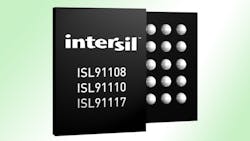Intersil’s ISL911xx buck-boost and boost switching regulator family promises to improve efficiency for high-current designs in a small form factor. The regulators are designed for battery-powered mobile devices and consumer electronics that use single-cell lithium (Li) batteries. Their efficiency, up to 96%, can prolong battery life and reduce overheating.
The family is based on a proprietary, fully synchronous four-switch architecture that allows a smooth transition from buck to boost. It also prevents glitches and delivers up to 2.5-A output current, even from a low-voltage single-cell Li battery.
The ISL91110 and ISL91108 buck-boost switching regulators can supply a mobile system’s power management IC (PMIC), a Wi-Fi or radio frequency (RF) power amplifier, and other system peripherals such as camera and memory interfaces. They also can provide 2 A of current from a 2.5-V supply. The ISL91108 in particular is highly efficient at light loads, for “always-on” applications.
The ISL91117 boost converter is for USB on-the-go implementations in handheld devices that require high current and high efficiency. The ISL91117 is available in both fixed 5-V as well as adjustable output voltage options.
The devices come in packages as small as 2.34 by 1.72 mm (advanced wafer-level chip-scale packaging). They require only a single inductor and very few external components, minimizing overall space requirements.
About the Author
Staff
Articles, galleries, and recent work by members of Electronic Design's editorial staff.
